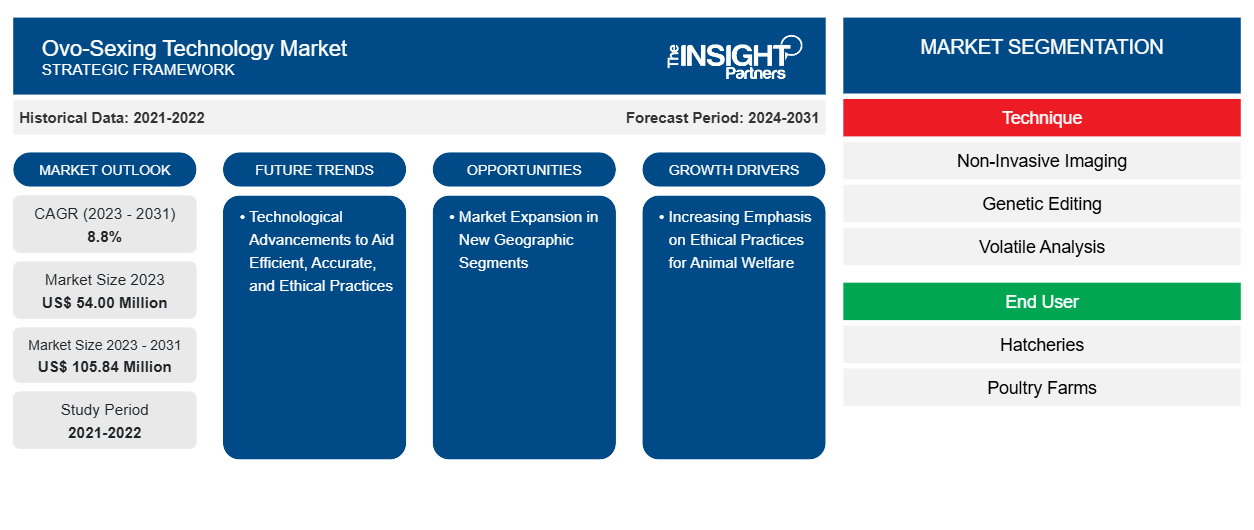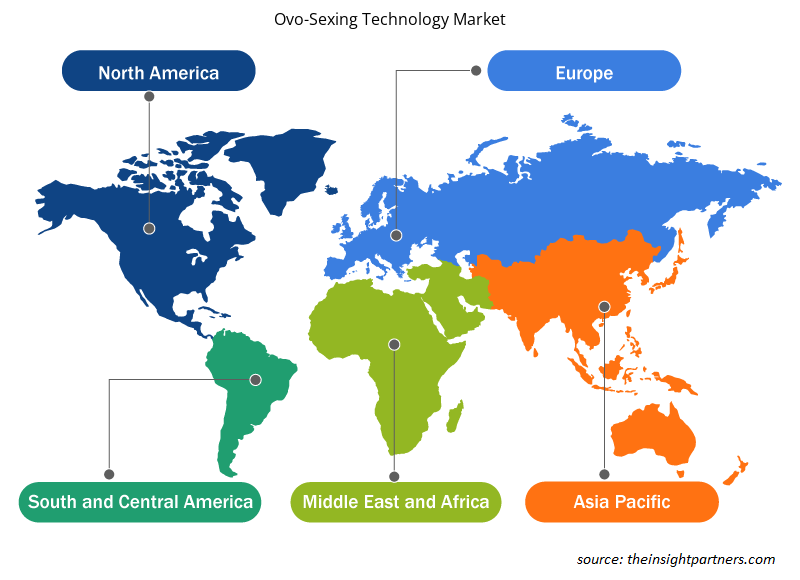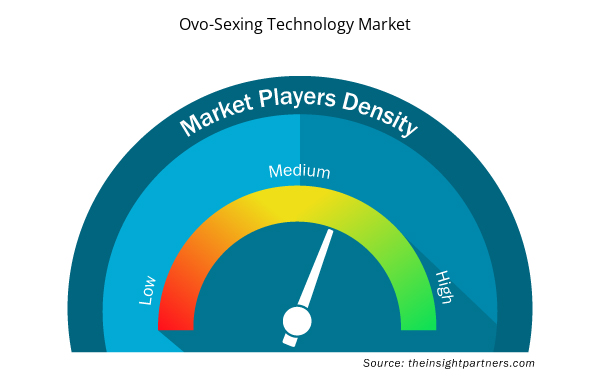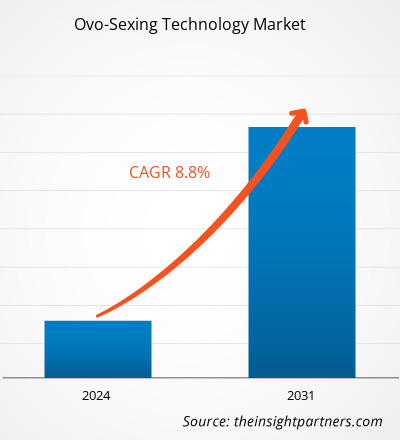The ovo-sexing technology market size is projected to reach US$ 105.848 million by 2031 from US$ 54.00 million in 2023. The market is expected to register a CAGR of 8.8% during 2023–2031. The technological advancements to aid efficient, accurate, and ethical practices are likely to act as a future trend in the ovo-sexing technology market in the coming years.
Ovo-Sexing Technology Market Analysis
Noninvasive imaging technology for ovo-sexing of chicks employs advanced techniques such as hyperspectral imaging, magnetic resonance imaging (MRI), Raman spectroscopy, and fluorescence spectroscopy. These methods enable the examination of the embryo inside an egg to determine its sex without harming the shell. Various egg producers are adopting and developing noninvasive imaging technologies to produce high-quality eggs and reduce the ethical concerns associated with traditional sex determination methods. Thus, the increasing emphasis on ethical practices for animal welfare creates a demand for in-ovo sexing methods, thereby generating a steady, sustainable market for manufacturers.
Ovo-Sexing Technology Market Overview
As per the survey published by Innovate Animal Ag in July 2023, ~47% of egg consumers in the US, i.e., nearly 122 million adults, are highly interested in eggs produced using in-ovo sexing, while the remaining 35% (91 million) were reported to be slightly interested. Additionally, 71% of egg buyers are willing to pay a premium for eggs produced using in-ovo sexing, with the median willingness to pay being just over 36 cents per dozen. The rising interest and willingness of consumers to pay more for in-ovo-sexed eggs is likely to drive the adoption of in-ovo sexing technologies by the poultry industry in the US. Poultry-based product companies, such as Vital Farms and Whole Foods, are likely to be early adopters of the in-ovo sexing technology in the US.
In-ovo sexing provides economic benefits through the early identification of male embryos, optimization of breeding programs, and reduction of costs associated with rearing unwanted male chicks. Thus, these techniques allow for more efficient resource allocation. Moreover, they create opportunities for value-added products, as specialty egg producers can market their eggs as more ethical, appealing to consumers who prioritize animal welfare.
Several companies and research institutions in the US are actively working to bring in-ovo sexing technologies to the country. For instance, Egg Innovations, an ethical farming company, plans to expand its Helpful Hens brand nationwide by 2025 with the implementation of in-ovo sexing technology in its egg production activities. The company has been a pioneer of regenerative farming practices through its Helpful Hens brand. Further, NestFresh announced the application of a noninvasive in-ovo sexing system in its egg operations in 2024, along with its plans to offer shell eggs produced from hens hatched with the technology by mid-2025. Therefore, the growing consumer acceptance of ovo-sexed eggs, coupled with the rising adoption of ovo-sexing technology by the poultry industry, is fueling the growth of the market in the US.
Customize This Report To Suit Your Requirement
You will get customization on any report - free of charge - including parts of this report, or country-level analysis, Excel Data pack, as well as avail great offers and discounts for start-ups & universities
Ovo-Sexing Technology Market: Strategic Insights

- Get Top Key Market Trends of this report.This FREE sample will include data analysis, ranging from market trends to estimates and forecasts.
Customize This Report To Suit Your Requirement
You will get customization on any report - free of charge - including parts of this report, or country-level analysis, Excel Data pack, as well as avail great offers and discounts for start-ups & universities
Ovo-Sexing Technology Market: Strategic Insights

- Get Top Key Market Trends of this report.This FREE sample will include data analysis, ranging from market trends to estimates and forecasts.
Ovo-Sexing Technology Market Drivers and Opportunities
Rising Focus on Commercialization of In-Ovo Sexing Methods Fuels Market
As per the research by Innovate Animal Ag, a nonprofit organization, ~78.4 million out of 389 million hens (i.e., ~20%) in the European Union were subjected to in-ovo sexing technology as of April 2024, representing a significant increase of 5% from the number of hens sexed in September 2023. Moreover, the number of in-ovo sexed hens is expected to surge with a rapid surge in the number of hatcheries adopting this technology, the expansion of existing machine capacities, and improvements in the efficiency of the technology with research and development. As per the same source, in-ovo sexed hens cost approximately €2.60 (US$ 2.83) more than conventional hens, translating to an additional 0.75 euro cents per table egg. These table eggs subsequently retail for an extra 1–3 cents per egg. Such attractive numbers motivate companies to invest in the development of commercially viable in-ovo sexing systems. For instance, NestFresh, a leader in humane and sustainable egg production, announced the adoption of cutting-edge in-ovo sexing technology in August 2024. This innovative method determines the sex of chicks when they are inside eggs, marking a significant advancement in animal welfare by eliminating the need to euthanize newborn male chicks. After the success of in-ovo sexing technologies in Europe, NestFresh set the standard in the US egg industry by implementing similar in-ovo sexing technologies for chicks in 2024.
Expansion in New Geographic Segments to Offer Opportunities for Market
As the demand for ethical poultry production grows globally, manufacturers can target emerging markets where traditional practices are still prevalent. Although in-ovo sexing is currently concentrated within a few European countries, including Germany, France, and the Netherlands, it is garnering significant interest in other parts of the world. The growing traction is evident through commitments from state governments in India; industry commitments in Mexico, Brazil, and Chile; investments in R&D by Australian and Japanese governments; and the emergence of multiple startups in Israel developing these technologies. According to an article published by the People for the Ethical Treatment of Animals (PETA) India, in June 2023, Maharashtra has committed to adopting in-ovo sexing technology to prevent the killing of male chicks. The state's Commissioner of Animal Husbandry has instructed district authorities to take action to stop the culling of chicks by using technologies that identify male embryos at an early stage.
Expanding into new markets often requires forming strategic partnerships with local businesses, distributors, or agricultural organizations. These partnerships can provide businesses with valuable insights into local consumer behavior. For instance, in April 2024, HatchTech, the parent company of an in-ovo sexing technology company named Respeggt, acquired Nytor, which has expertise in designing and developing molecular assays such as allantoic sampling tests used for in-ovo sexing. The partnership aims to reduce the costs of in-ovo sexing, making it appealing to all-layer hatcheries, even in countries without bans on chick culling.
Ovo-Sexing Technology Market Report Segmentation Analysis
Key segments that contributed to the derivation of the ovo-sexing technology market analysis are technique and end user.
- The ovo-sexing technology market, based on technique, is segmented into noninvasive imaging, genetic editing, volatile analysis, sex reversal, and liquid-based analysis. The noninvasive imaging segment held the largest share of the market in 2023, and it is expected to register the highest CAGR during 2024–2031.
- In terms of end user, the ovo-sexing technology market is segmented into hatcheries and poultry farms. The hatcheries segment held a larger share of the market in 2023.
Ovo-Sexing Technology Market Share Analysis by Geography
The geographic scope of the ovo-sexing technology market report is mainly divided into 5 major regions: US, Germany, France, Italy, Spain, Rest of Europe, Israel, ROW. Germany dominated the market in 2023. According to a study published in September 2023 by the University of Hohenheim in Germany, raising male chicks for meat in the egg industry has a more extensive environmental impact compared to conventional broilers. In addition, chick culling generates an industry waste valued at US$ 500 million annually, and the approach is unpopular among consumers. With the rising animal welfare concerns related to male chick culling, the German government banned the industrial killing of male chicks in January 2022. Due to this legislative ban, in-ovo sexing technologies are gaining traction among government bodies, animal welfare organizations, and the poultry industry in Germany.
The in-ovo sexing is a cost-effective method that improves productivity for hatcheries by freeing up space previously used by male chicks. Eggs produced using in-ovo sexing retail for only 1–3% higher cost per egg; this cost increase includes greater margins for the technology companies, hatcheries, egg producers, and retailers. Since 2021, in-ovo sexing has become the primary method adopted by the poultry industry for complying with the nationwide ban on chick culling. German companies including Respeggt Group, AAT, Orbem, and Plantegg are offering commercialized solutions in the in-ovo sexing technology market. For example, the technology developed by Respeggt Group identifies the sex of developing embryos at day 9. Further, Plantegg uses a PCR method that utilizes DNA for the sex detection of hatching eggs.
Ovo-Sexing Technology Market Regional Insights
The regional trends and factors influencing the Ovo-Sexing Technology Market throughout the forecast period have been thoroughly explained by the analysts at Insight Partners. This section also discusses Ovo-Sexing Technology Market segments and geography across North America, Europe, Asia Pacific, Middle East and Africa, and South and Central America.

- Get the Regional Specific Data for Ovo-Sexing Technology Market
Ovo-Sexing Technology Market Report Scope
| Report Attribute | Details |
|---|---|
| Market size in 2023 | US$ 54.00 Million |
| Market Size by 2031 | US$ 105.84 Million |
| Global CAGR (2023 - 2031) | 8.8% |
| Historical Data | 2021-2022 |
| Forecast period | 2024-2031 |
| Segments Covered |
By Technique
|
| Regions and Countries Covered | North America
|
| Market leaders and key company profiles |
Ovo-Sexing Technology Market Players Density: Understanding Its Impact on Business Dynamics
The Ovo-Sexing Technology Market market is growing rapidly, driven by increasing end-user demand due to factors such as evolving consumer preferences, technological advancements, and greater awareness of the product's benefits. As demand rises, businesses are expanding their offerings, innovating to meet consumer needs, and capitalizing on emerging trends, which further fuels market growth.
Market players density refers to the distribution of firms or companies operating within a particular market or industry. It indicates how many competitors (market players) are present in a given market space relative to its size or total market value.
Major Companies operating in the Ovo-Sexing Technology Market are:
- Orbem GmbH;
- In Ovo BV;
- Respeggt Group;
- Omegga GmbH;
- eggXYt;
Disclaimer: The companies listed above are not ranked in any particular order.

- Get the Ovo-Sexing Technology Market top key players overview
Ovo-Sexing Technology Market News and Recent Developments
The ovo-sexing technology market is evaluated by gathering qualitative and quantitative data post primary and secondary research, which includes important corporate publications, association data, and databases. A few of the developments in the market are listed below:
- Agri Advanced Technologies GmbH is bringing the next development step into practice. With the help of hyperspectral imaging, the company has further developed its Cheggy process, which is already used throughout Europe, and is now using the optimized "Cheggy Zoom" process for the first time in a hatchery in Germany. (Source: Agri Advanced Technologies GmbH, Company Website, December 2023).
- In Ovo have secured a €40 million loan agreement with the European Investment Bank (EIB). This huge cash injection is set to turbocharge In Ovo’s mission to level up its Ella technology and kickstart other projects, aimed at boosting animal welfare and promoting green operations in the poultry sector. (Source: In Ovo BV, Company Website, November 2023)
Ovo-Sexing Technology Market Report Coverage and Deliverables
The "Ovo-Sexing Technology Market Size and Forecast (2021–2031)" report provides a detailed analysis of the market covering below areas:
- Ovo-sexing technology market size and forecast at global, regional, and country levels for all the key market segments covered under the scope
- Ovo-sexing technology market trends, as well as market dynamics such as drivers, restraints, and key opportunities
- Detailed PEST and SWOT analysis
- Ovo-sexing technology market analysis covering key market trends, global and regional framework, major players, regulations, and recent market developments
- Industry landscape and competition analysis covering market concentration, heat map analysis, prominent players, and recent developments for the ovo-sexing technology market
- Detailed company profiles
- Historical Analysis (2 Years), Base Year, Forecast (7 Years) with CAGR
- PEST and SWOT Analysis
- Market Size Value / Volume - Global, Regional, Country
- Industry and Competitive Landscape
- Excel Dataset


- Semiconductor Metrology and Inspection Market
- Fixed-Base Operator Market
- Hydrolyzed Collagen Market
- Emergency Department Information System (EDIS) Market
- Joint Pain Injection Market
- Truck Refrigeration Market
- Medical Enzyme Technology Market
- Space Situational Awareness (SSA) Market
- Wind Turbine Composites Market
- Smart Locks Market

Report Coverage
Revenue forecast, Company Analysis, Industry landscape, Growth factors, and Trends

Segment Covered
This text is related
to segments covered.

Regional Scope
North America, Europe, Asia Pacific, Middle East & Africa, South & Central America

Country Scope
This text is related
to country scope.
Frequently Asked Questions
The market is expected to register a CAGR of 8.8% during 2023–2031.
The ovo-sexing technology market value is expected to reach US$ 54.00 million by 2031.
Technological advancements in ovo-sexing technology to aid efficient, accurate, and ethical practices are expected to emerge as a prime trends in the market in the coming years.
Germany dominated the market in 2023.
The increasing emphasis on ethical practices for animal welfare and rising focus on commercialization of in-ovo sexing methods are among the most significant factors fueling the market growth.
Orbem GmbH; In Ovo BV; Respeggt Group; Omegga GmbH; eggXYt; SOOS Technology Ltd; PLANTegg GmbH; and Agri Advanced Technologies GmbH are among the key players in the market.
Trends and growth analysis reports related to Life Sciences : READ MORE..
The List of Companies - Ovo-Sexing Technology Market
- Orbem GmbH
- In Ovo BV
- Respeggt Group
- Omegga GmbH
- eggXYt
- SOOS Technology Ltd
- PLANTegg GmbH
- Agri Advanced Technologies GmbH

 Get Free Sample For
Get Free Sample For